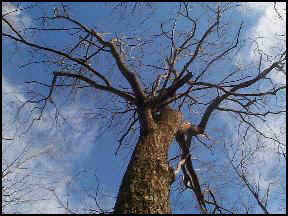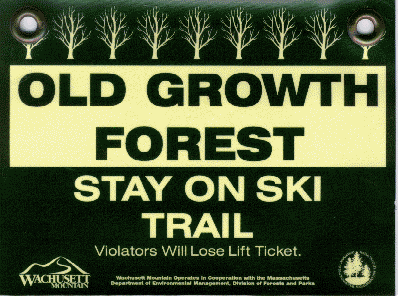Wachusett Mountain is home to an irreplaceable natural resource feature that needs to be protected. I am talking about the Old Growth Forest that surrounds the 2006 foot high summit. A universal definition does not exist for an old growth forest because forests are so different around the globe. In the northeastern United States most experts agree that old-growth are those that:
- Are at least ten acres in size, which is large enough for them to be self-sustaining.
- Contain trees that are greater than 50% of the maximum known age for a particular species.
- Have not been cleared for agriculture or timber harvest.
The forest at Wachusett Mountain grows in a harsh and fragile environment. The rocky soil on the steep slopes is thin and infertile. The trees have been exposed to frequent ice storms and strong winds that have damaged their branches and caused the trees to grow slowly. Because of the bad form of these trees, they have no value as lumber. The steep slopes also make it difficult to harvest the trees for timber.

Wachusett Mountain is the highest mountain east of the Conneticut River in Massachusetts, and is the only area known to contain old-growth in this region. There are over 100 acres on the mountain. Native Americans used the slopes for hunting and considered the mountain sacred. Europeans, who first described Wachusett Mountain in 1632 didn’t begin clearing the slopes until 1734. By 1830, most of the land below the 1500-foot elevation had been cleared for farming and timber. The areas of forest that were not disturbed remain as old-growth today. The old-growth trees on Wachusett are between 150-350 years depending on the species.

The best viewing of old-growth on the Midstate Trail is along the Old Indian Trail inside the Wachusett Mountain State Reservation. All the old-growth is within the reservation which is managed by the Massachusetts Department of Enviromental Management. We have an obligation to understand and protect the environment. The best way hikers can protect this vital natural resource is to follow all posted rules and regulations, especially:
- Stay on marked trails.
- Do not disturb plants, soils, stones or structures.
- Leave nothing but footprints.
- Take nothing but memories and pictures.
- This is a fragile and rare environment that deserves everyone’s respect.
Leave No Trace means traveling and camping with care, deliberately planning, and guiding one’s actions so as not to harm the environment or disturb others.
